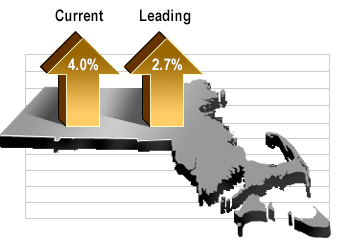State economy rebounds notably in Q2, UMass Journal Reports
Surge in wage and salary growth accounts for strong performance.
June 2017
 Massachusetts real gross domestic product grew 4.0 percent in the second quarter of 2017 according to the MassBenchmarks Current Economic Index, released today by MassBenchmarks, the journal of the Massachusetts economy published by the UMass Donahue Institute in collaboration with the Federal Reserve Bank of Boston. U.S. real gross domestic product grew 2.6 percent during the same period, according to the U.S. Bureau of Economic Analysis (BEA).
Massachusetts real gross domestic product grew 4.0 percent in the second quarter of 2017 according to the MassBenchmarks Current Economic Index, released today by MassBenchmarks, the journal of the Massachusetts economy published by the UMass Donahue Institute in collaboration with the Federal Reserve Bank of Boston. U.S. real gross domestic product grew 2.6 percent during the same period, according to the U.S. Bureau of Economic Analysis (BEA).
Based on the latest available data, the BEA estimates that the state grew 1.1 percent in the first quarter of 2017, as compared to 1.2 percent nationally. While the pace of growth of both the state and the U.S. accelerated from the first quarter, a surge in wage and salary growth in Massachusetts during the second quarter accounted for the state's relatively faster growth in April, May, and June. Wage and salary income for Massachusetts, as estimated from state withholding taxes, shot up by 24.0 percent on an annual basis in the second quarter, after growing 3.7 percent in the first quarter. U.S. wage and salary income is estimated to have grown 3.7 percent in the second quarter (BEA's estimate will be released on August 1), and 4.0 percent in the first quarter of 2017. Relative to the second quarter of 2016, state wage and salary income is up 6.2 percent while national wage and salary income is up 3.1 percent.
Employment in both Massachusetts and the U.S. has continued to grow at modest rates typical of this long economic expansion. In the second quarter of 2017, Massachusetts payroll employment expanded at a 0.9 percent annual rate after growing by 2.2 percent in the first quarter. U.S. payroll employment grew at a 1.4 percent annual rate in the second quarter and at a 1.5 percent rate in the first quarter. Between the second quarter of 2016 and the second quarter of 2017, employment grew at virtually the same rate in Massachusetts as nationally, by 1.7 percent and 1.6 percent respectively.
During the first half of 2017 both state and national labor markets strengthened notwithstanding a rising state unemployment rate during the same period. In Massachusetts, the unemployment rate rose from 3.1 percent in December 2016 to 3.6 percent in March and 4.3 percent in June, while the U.S. unemployment rate fell from 4.7 percent in December to 4.5 percent in March and 4.4 percent in June. The rise in the state's unemployment rate reflects a rapid increase in the labor force that outpaced rising employment in the first six months of the year. This rapid increase in the size of the Commonwealth's labor force — indicative of a healthy labor market attracting new or returning job-seekers into the labor force — explains the seeming paradox of both rising employment and a rising unemployment rate.
The broader U-6 unemployment rate, which counts as unemployed those who are working part-time but want full-time work and those who want to work but have not looked for work in the last four weeks, followed a similar pattern. In Massachusetts, the U-6 rate rose from 7.5 percent in December to 7.8 percent in June, while for the U.S. it fell from 9.2 percent in December to 8.6 percent in June. Again, the increase in the U-6 for Massachusetts is not the result of an increase in involuntary part-time workers or an increase in those marginally-attached to the labor force; rather it reflects the rapid increase in persons rejoining or entering the labor force for the first time.
Consumer and business spending on items subject to the state regular sales and motor vehicle sales taxes declined slightly, by a 1.4 percent annual rate, in the second quarter after rising at a 9.3 percent rate in the first quarter. Sales tax eligible spending was 2.9 percent higher in the second quarter of this year than in the second quarter of last year. The dip in the first quarter reflects typical quarterly volatility in this measure rather than clear evidence of a retrenchment in consumer spending. Consumer spending appears to continue to grow at a moderate pace, consistent with moderate increases in consumer confidence.
The MassBenchmarks Leading Index suggests that the state's economy will continue to grow at a moderately strong pace — a 2.7 percent annual rate — for the final six months of 2017. This pace of growth is sustainable provided skilled job seekers continue to be available to support the expansion of the Commonwealth's growing employers. Labor supply can be expected to increasingly become a constraint on state economic growth as the Massachusetts economy contends with the demographic constraints of an aging workforce.
MassBenchmarks is published by the University of Massachusetts Donahue Institute in cooperation with the Federal Reserve Bank of Boston. The Donahue Institute is the public service, outreach, and economic development unit of the University of Massachusetts Office of the President. The Current and Leading Indexes are compiled and analyzed by Dr. Alan Clayton-Matthews, Associate Professor of Economics and Public Policy at Northeastern University and released quarterly by MassBenchmarks.
For a full breakdown of the latest indexes, click here. A comprehensive analysis of the state of the Massachusetts economy can be found in the most recent issue of MassBenchmarks.

